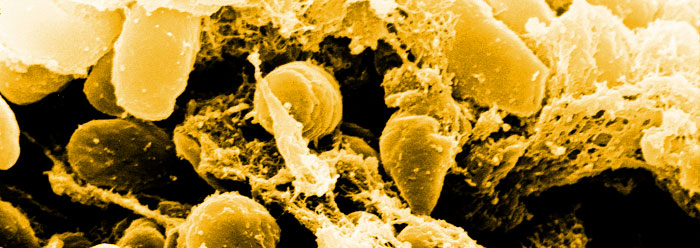The bacteria that cause the plague have killed many people throughout history.1 Scientifically named Yersinia pestis, the bacteria enter human and animal bodies often through flea bites.
Although instances of the disease are not nearly as common today, it remains a dangerous threat. Researchers have thus been searching the bacteria cells' inner workings for keys to their ability to cause disease.
Y. pestis causes bubonic plague, or "Black Death," when it infects the lymph system. The gruesome process begins with the formation of "buboes," swollen nodules at limb joints, and then progresses to darkly colored spots all over the body. If untreated, death typically results in less than a week.
One strain of the bacteria can also infect the lungs and cause pneumonic plague, which is even more virulent.
However, Y. pestis is very closely related to the common gut and soil bacteria Yersinia pseudotuberculosis, which can cause a mild intestinal infection, and to about 12 other species of Yersinia. Why is one strain so much more dangerous than the others?
Researchers, publishing in the Proceedings of the National Academy of Sciences, found that small RNA molecules may make the difference.2 These "sRNAs" regulate bacterial protein production according to complicated feedback networks.
The researchers found that the Y. pestis species was missing six sRNAs that Y. pseudotuberculosis possesses. Further, these six sRNAs regulate the production of proteins that help enable the bacteria to cause disease.
Jovanka Koo, lead author of the report, said in a Northwestern University news release:
An important lesson is that small changes can have big effects on sRNA functions. They can affect when an RNA is expressed or produced, the way that RNA folds, and the ability of that RNA to affect the regulated protein coding RNA.3
Could a loss of important sRNAs in an ancient population of Y. pseudotuberculosis have led to Y. pestis and the plague? If so, this would again demonstrate that disease-causing germs resulted not from direct creation or Darwinian evolution, but rather from the sin-cursed condition of this world, in which all living systems are subject to corruption and decay.4, 5
These bacteria have complicated and intricate inter- and intra-cellular communication systems that enable them to survive and even optimize their quality of life by forming micro-ecological zones, by exchanging DNA, and by coordinating activity with adjacent intestinal and bacterial cells amid rapidly changing environments.6 Likewise, Yersinia exercise the "fine-tuning" and "regulation" required for "the adaptation of pathogenic bacteria to the host."2
Thus, according to the evidence, Yersinia was originally well-created as a useful soil and gut bacteria, but some of the formerly precise mechanisms appear to have broken down in Y. pestis.2 The intricate cell-host communication systems were marred after sin entered the world through Adam, resulting in pathogenic instead of beneficial bacteria.
References
- Welsh records contain some of the earliest references to European plagues that were very likely caused by Black Death, dating to the 500s AD. See Cooper, W. R. (trans.). 2002. The Chronicle of the Early Britons, 60.
- Koo, J. T. et al. 2011. Global discovery of small RNAs in Yersinia pseudotuberculosis identifies Yersinia-specific small, noncoding RNAs required for virulence. Proceedings of the National Academy of Sciences.108 (37): E709-E717.
- From Mild Mannered to Killer. Northwestern University Feinberg School of Medicine news release, August 29, 2011.
- Thomas, B. Where Did Flesh-eating Bacteria Come From? ICR News. Posted on icr.org December 15, 2008, accessed September 13, 2011.
- Wood, T. C. 2001. Genome Decay in the Mycoplasmas. Acts & Facts. 30 (10).
- Anderson, K. L. 2003. The complex world of gastrointestinal bacteria. Canadian Journal of Animal Science. 83 (3): 409-427.
* Mr. Thomas is Science Writer at the Institute for Creation Research.
Article posted on September 21, 2011.




